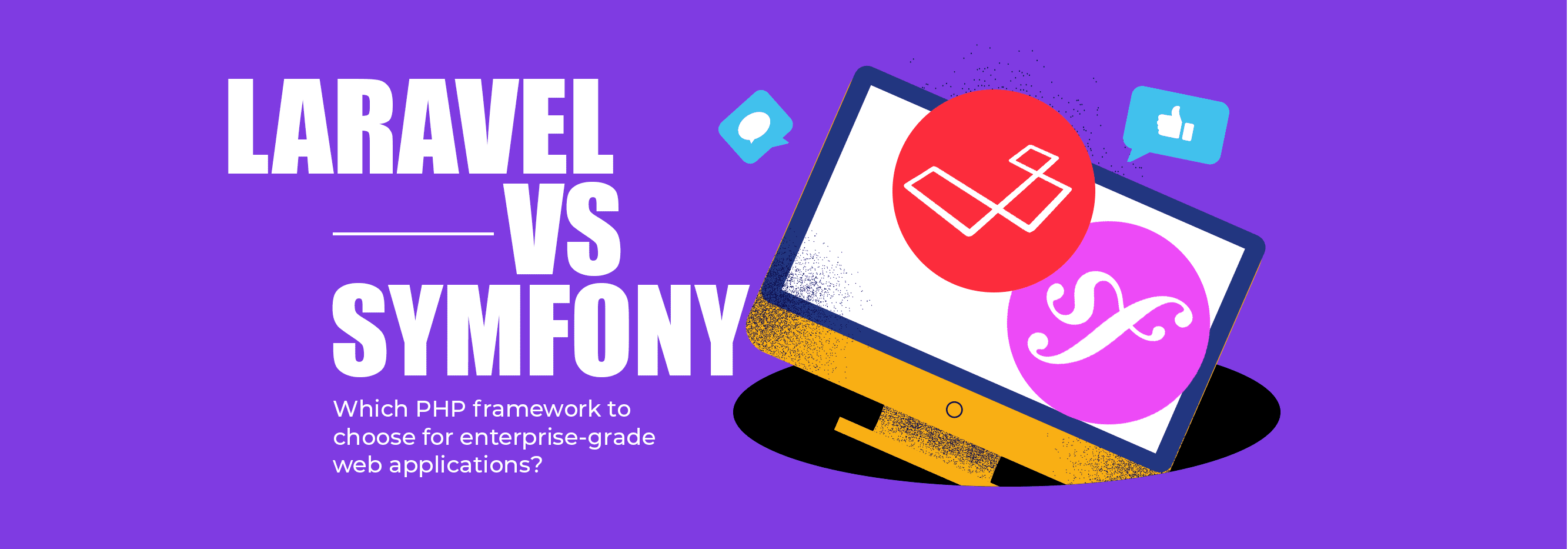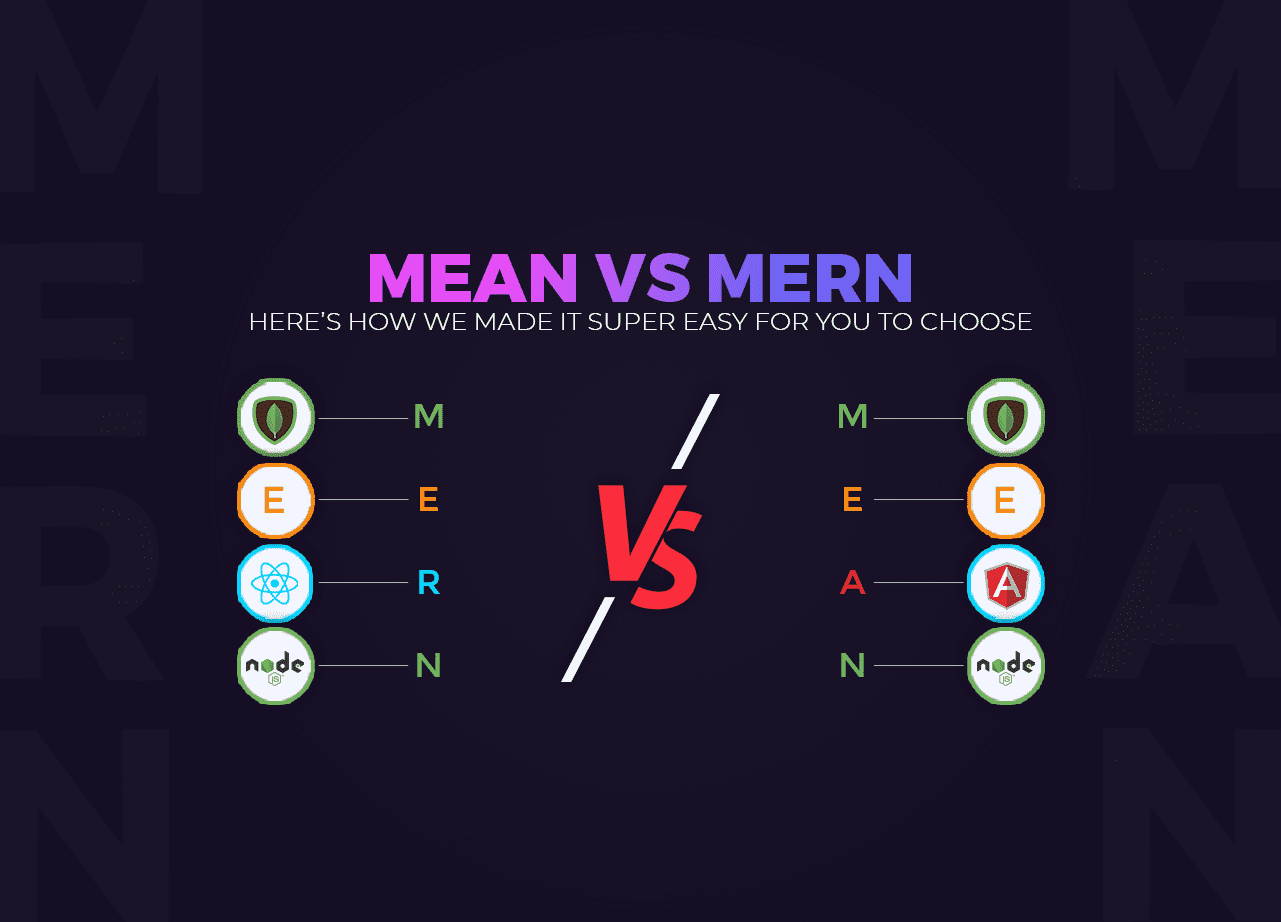From small businesses to large-scale enterprises, everyone needs high functioning and efficient web applications, and the PHP frameworks are the first choice for developers for building highly scalable web applications.
Two of the best-suited PHP frameworks for developing enterprise-grade web applications are- Symfony and Laravel.
Symfony VS Laravel is an extremely difficult choice to make for business owners and web developers alike.
In this article, our experts have encapsulated a complete comparison between Laravel and Symfony by examining their most important aspects, benefits, drawbacks and use cases.
So without further ado, let’s discuss the basic definitions of Laravel and Symfony.
Introduction: Laravel VS Symfony
What is Laravel?
“The PHP Framework For Web Artisans”
Laravel is an open-sourced PHP web framework, adored by developers for its exceptional benefits like server-side routing, blade templating, HTML authentication, etc.
Developed by Taylor Otwell and released in 2011, Laravel’s architecture is Symfony-based and written in PHP with reusable libraries and components.
This PHP framework can be used to develop dynamic, modern and robust web applications using the MVC architecture. Laravel provides many tools and benefits for developing a flexible backend for full-stack development, SaaS products, high performing web applications and more.
What is Symfony?
“A PHP Web Framework with Reusable PHP Components”
Symfony is a PHP-based web framework that is open-sourced in nature and follows the MVC architectural design. PHP developers enjoy using Symfony for building high functioning and scalable enterprise-grade web applications because of its Rapid Application Development (RAD) environment.
Initially released in 2005, the original author of Symfony is Fabien Potencier. The MVC pattern simplifies the development process and stabilizes the performance of the web application.
Additionally, Symfony can be efficiently used and integrated with the best front-end frameworks like React and Angular.
Popularity & Community: Laravel VS Symfony
In terms of most talked about or most discussed, the data from StackOverflow provides a clear comparison between Symfony VS Laravel:
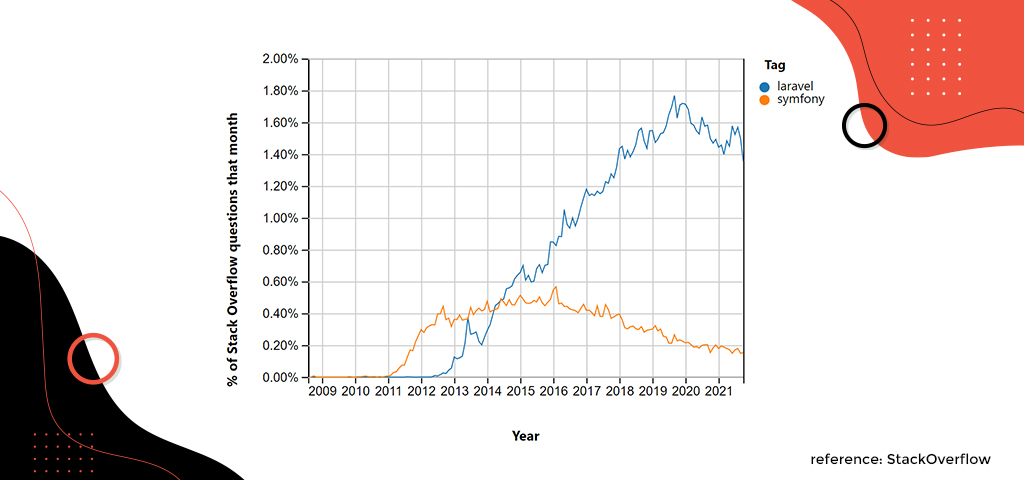
Image Source: StackOverflow
Symfony maintained its popularity over the years, but Laravel’s popularity soared right after its inception, making it clear that Laravel is the most talked about or asked about PHP framework when compared between Symfony VS Laravel.
The following data by statisticsanddata provides a clear picture about the popularity in terms of usage:

Image Source: Statisticsanddata
As of March 2021, Laravel is the most used among the top backend frameworks, proving once again, the significance of Laravel around the world.
Maturity and community support are significant aspects of a web development framework.
A well-matured framework with strong community support provides the necessary documentation, tools, libraries and source codes for an easy development process.
GitHub accurately represents the maturity for a web framework, let’s look at the data:
| GitHub Stars | GitHub Forks | |
|---|---|---|
| Laravel | 67.4k | 21.8k |
| Symfony | 26k | 8.4k |
Performance: Laravel VS Symfony
Although Laravel is used for complex enterprise-grade web applications, the performance and speed can be slow at times. But there are many ways to enhance the performance by optimizing the backend logic, facilitating web applications to run efficiently and seamlessly below 20ms.
Already stored data and information can be utilized to further improve the performance and latency of a Laravel-based web application with the help of cache tags.
Symfony is also used for delivering high performing enterprise-grade web applications, showing better performance than many other backend frameworks.
Here’s the data from a study conducted to test the performance and memory usage of the top PHP frameworks:
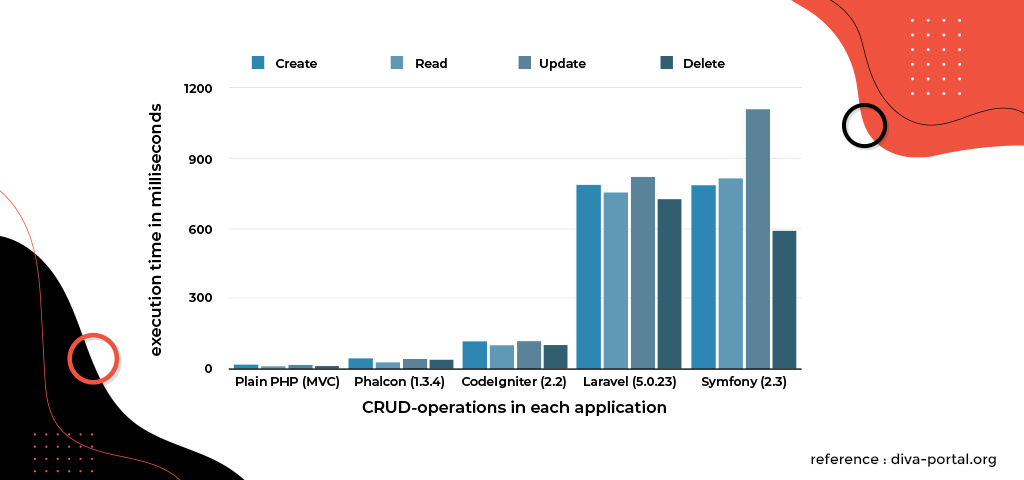
Image Source: Diva-portal
According to the above-mentioned data, Symfony requires more time to execute functionalities and consumes the most memory when compared to other PHP frameworks. Yet, Symfony is still widely accepted because it is used for large-scale projects, and heavy web applications require more time and memory to execute complex functionalities.
Scalability: Laravel VS Symfony
Many enterprise-grade web applications are using Laravel and successfully scaling up over the years. Being a PHP-based framework, continuous support and maintenance are available from the ever-growing community, making it ideal for businesses of all sizes.
Maximum scalability can be attained by using an effective database management system like MySQL. The load balancer and modern caching systems can also be used to enhance scalability even more.
Symfony is ideal for large scale web projects because of its high scalability. It uses a set of reusable PHP components with third-party containers for efficient and convenient scaling.
This PHP framework utilises Kubernetes to further enhance its flexibility and scalability. To manage more and more users on your Symfony-based web application, you must adhere to the following suggestions:
- Cache storage should be done using Redis
- Handle filestores by utilising FlySystem
Architecture: Laravel VS Symfony
Laravel is based on the Model-View-Controller framework architecture which allows the developer to segregate different parts of the web application for an easy and efficient development process. For instance, one developer can work on the frontend part of the development, while another develops the backend logic at the same time.
The MVC architecture offers complete control to the developer in the development process. Additionally, the codebase and the backend logic can easily be reused with an MVC architectural pattern along with effortless API integrations and enhanced SEO capabilities. Therefore, the MVC structure helps you create web applications with flexible backends for long-term usage.
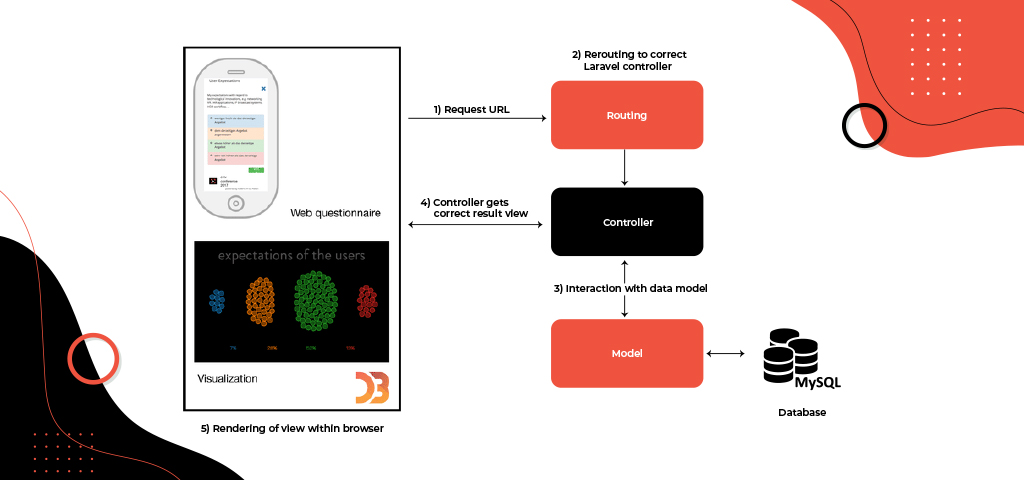
Image Source: Researchgate
Symfony is also an MVC-based PHP framework with the same components: Model-View-Controller. This type of structure lets you handle different parts of the codebase logic separately.
For instance, if you need your web application to be compatible with handheld devices, you just have to modify the View component, without editing the codebase.
The Controller component is responsible for keeping the request protocol separated from the View and Model components. Each component can be tweaked individually without affecting other parts of the web application, maximising flexibility.
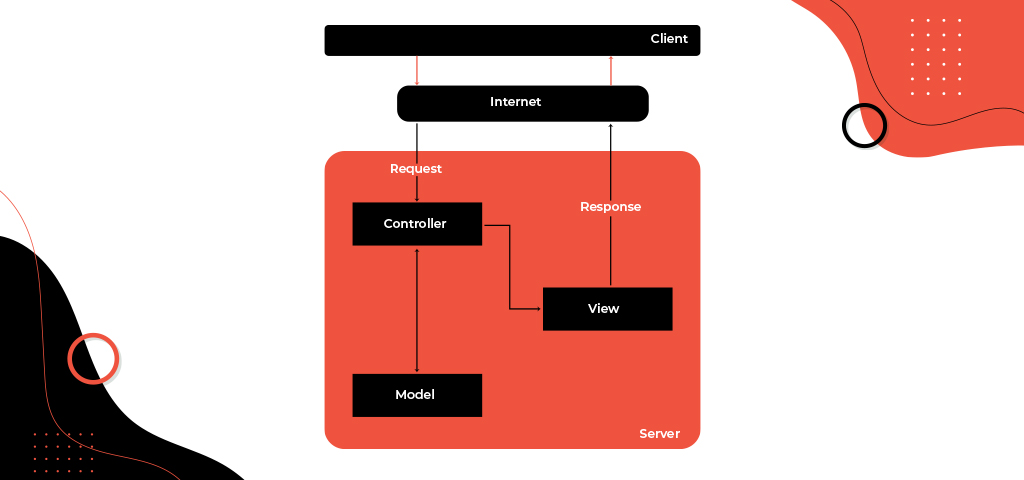
Testing: Laravel VS Symfony
Bearing in mind that Laravel is a PHP-based framework, there is an abundance of tools accessible for testing your web application, enabling a post-development testing process that delivers a flawless web application.
Testing in a Laravel-based web application occurs in two different levels:
- Unit tests
- Feature tests
The tools and documentation available for testing a web application in the Laravel framework are more than adequate. Additionally, developers can execute mock tests to make sure that the web application code is error-free and ready to launch.
Symfony facilitates efficient post-development testing with tools like:
- Pretty Printer
- Blackfire
- PHPUnit
PHP developers can utilize Doctrine Bundles for easily spotting and eradicating bugs to reliably test the web application. Symfony allows you to run all types of tests on your web application- Functional tests, integration tests, unit tests, etc.
Microservices: Laravel VS Symfony
The Laravel PHP framework supports the microservices architecture quite efficiently. It divides the application logic in a modular pattern, separating them into small units which serves different functionalities.
APIs are used to link the modules and deliver constant communication with each other, providing the perfect environment for the microservices architecture.
Another lightweight alternative, the Lumen framework was developed specifically for using the microservices architecture with Laravel.
Symfony can be used with microservices architecture using the Microkernel feature. This enables rapid development speed with lesser coding and quicker deployment.
The Microkernel feature provides unique service containers that serve different functions. Whenever a user executes any function on your web application, these service containers trigger the required actions and functionalities.
Database Management: Laravel VS Symfony
Presently, Laravel supports 4 database management systems:
- Postgres
- SQLite
- SQL
- MySQL
Query builders like Eloquent ORM and raw SQL further enhance and simplify the interaction with the database management systems.
The web application development process is completely unconstrained with the available database management systems in Laravel.
Symfony interlinks database with the help of Doctrine ORM. This PHP web framework connects the database with the objects by utilising data mappers. This structure keeps the database and object model segregated, enabling high flexibility as any modifications made to the data won’t affect the codebase.
Symfony facilitates a wide range of Database Management Systems:
- SQLServer
- SQLite
- PostgreSQL
- SAL Sybase SQL Anywhere
- Oracle
- Drizzle
- MySQL
Pros & Cons: Laravel VS Symfony
Now that we have discussed the comparison between the significant aspects, let’s look at the pros and cons of Laravel and Symfony
Advantages of Laravel:
- Pre-built packages are available for executing simple functions like testing APIs and user authentication, further simplifying the web app development process;
- Blade Templating system lets you modify data and add new features/modules without affecting the web application logic;
- Reverse Routing automates the creation of URIs (Uniform Resource Identifiers), increasing flexibility and creating a connection between relevant links and Laravel routes;
- Artisan CLI facilitates the automation of repetitive tasks in the web application, increasing usability even more;
- Post-development testing is also automated in the Laravel PHP framework, saving valuable time and creating an environment for launching bug-free web applications;
- In-built security system features efficient authorization and authentication, providing a safeguard against unauthorized or unregistered users. Also, Laravel’s Object-Relational Mapping (ORM) utilises PDO that fends off hidden or unintended SQL injections.
Advantages of Symfony:
- High flexibility: Allows modifications and tweaks to the codebase from design to deployment;
- High Scalability: Allows you to utilise pre-built bundles to add features and functionalities;
- Twig Engine: One of the most powerful and popular PHP template engines;
- Time-Saving: Facilities rapid development speed with reusable components;
- Stable Environment: Features stable functioning in all versions with continual support from the community;
- Caching: Offers exceptional caching management with efficient database management systems, improving the performance and speed of the web application.
Disadvantages of Laravel:
- The Laravel is a lightweight PHP framework, it can feel like a benefit in some cases but it adversely affects the performance of the web application due to data bottleneck;
- Even though Laravel is open-sourced with large community support, it gives rise to undependable third-party libraries;
- System upgrades may cause problems to the web application, that’s why it is recommended to take precautions before updating the Laravel version.
- The development process seems slower when compared to other PHP frameworks in some cases.
Disadvantages of Symfony:
- Steep Learning Curve: Symfony is difficult and time-consuming to master for developers;
- Symfony requires more time to build a web application sometimes because it requires high technical proficiency;
- Parsing Problem: Lever and Parser codes are difficult to access and test;
- Symfony-based web applications deliver low performance at times like when there is a sudden surge of users.
Use Cases: Laravel VS Symfony
When should you use Laravel?
- Steaming platform web applications;
- EdTech web applications;
- Web applications for stock trading;
- Recognition and rewards based web applications;
- SaaS-based web applications;
- CMS systems with multilingual functionalities;
- Monitoring and tracking apps for website performance;
- SEO-friendly web applications;
- Web applications with unmatched security to prevent SQL injections, unauthorized users, etc.
When should you use Symfony?
- Single Page Applications
- Content Management System (CMS)
- Social Networking Websites
- Intranet tools and software
- Enterprise-Grade Web Applications
- Bulletin Board Software
- Web Applications with real-time data
- Customizable and scalable marketplace
Conclusion
Between Symfony VS Laravel, it is extremely difficult to declare a definitive winner because of the similar use cases of these PHP frameworks.
Laravel VS Symfony is a long-standing debate among web developers and business owners. Both Laravel and Symfony are ideal for building enterprise-grade web applications with minor differences. Laravel exhibits high usability, while Symfony facilitates better database and caching management.
You have to leverage the minor differences and balance the pros and cons to make well-informed decisions for your web app development. We hope this guide has helped you in your decisions.
If you need further assistance, feel free to contact us.
With a wide range of clientele and 16+ years of hands-on experience, Communication Crafts provides expert Laravel developers and top-notch PHP development, delivering highly scalable and result-driven web development solutions for building top-quality web applications.
Building your present, for a fruitful future.
 Blog Communication Crafts
Blog Communication Crafts